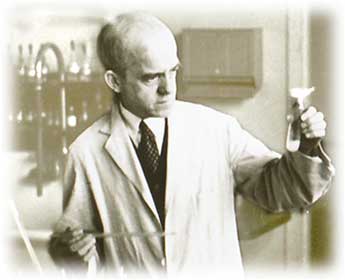Oswald Avery (c.1930)

In a very simple experiment, Oswald Avery's group showed that DNA was the "transforming principle." When isolated from one strain of bacteria, DNA was able to transform another strain and confer characteristics onto that second strain. DNA was carrying hereditary information. With DNA as the hereditary molecule, the stage was set for one of the most exciting periods in DNA science: understanding DNA structure and function.
oswald avery,dna structure and function,dna science,strain of bacteria,structure of dna,transforming principle,structure and function,molecule,periods
- ID: 15674
- Source: DNALC.DNAi
Related Content
16374. Concept 17: A gene is made of DNA.
Oswald Avery's team proves that DNA, not protein, is the genetic molecule.
16393. Problem 17: A gene is made of DNA.
Experiment with rough and smooth Pneumococcus DNA.
16705. Animation 34: Genes can be moved between species.
Stanley Cohen and Herbert Boyer transform bacteria with a recombinant plasmid, and Doug Hanahan studies induced transformation.
16375. Animation 17: A gene is made of DNA.
Oswald Avery explains Fred Griffith's and his own work with Pneumococcus bacteria.
16381. Gallery 17: Oswald Avery's letter to his brother, 1943
A page from the May 15, 1943 letter from Oswald Avery to his brother Roy. In the letter Avery speculated on how transformation could happen. Avery never publicly connected genes with DNA and his transformation experiments.
16391. Biography 17: Oswald Theodore Avery (1877-1955)
In 1944, Oswald Avery and his colleagues, Colin MacLeod and Maclyn McCarty published their landmark paper on the transforming ability of DNA.
16626. Concept 29: DNA is packaged in a chromosome.
Each chromosome is a package for one very long, continuous strand of DNA.
16395. Animation18: Bacteria and viruses have DNA too.
Joshua Lederberg worked with bacterial genetics while Alfred Hershey showed that DNA is responsible for the reproduction of new viruses in a cell.
16390. Video 17: Maclyn McCarty, clip 6
How the bacterial transformation experiments provided the first real opportunity to study the chemical nature of the gene.












